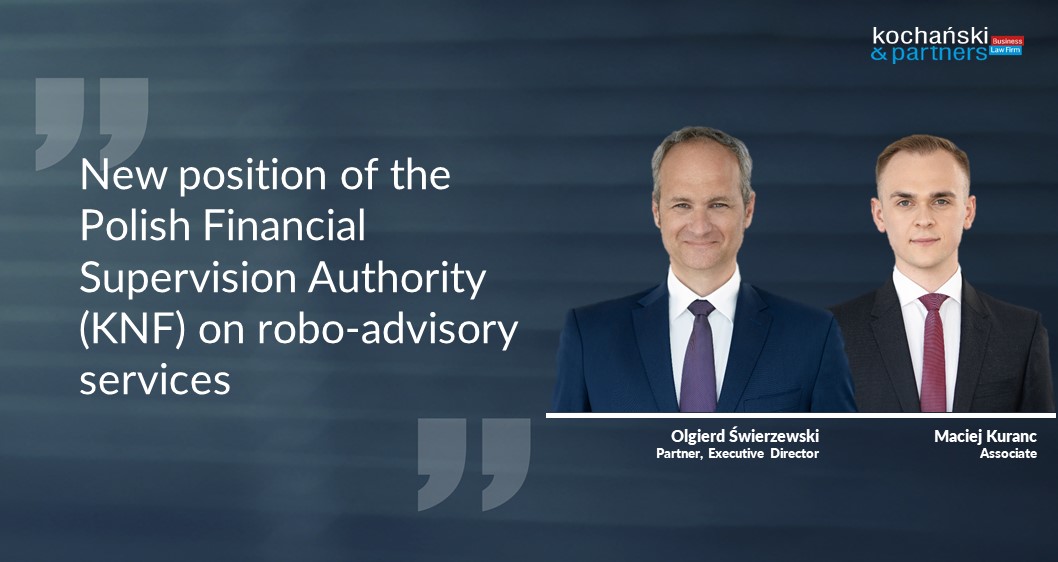
New position of the Polish Financial Supervision Authority (KNF) on robo-advisory services
On 4 November, the Office of the Polish Financial Supervision Authority (“UKNF”) published its position on the provision of the so-called “robo-advisory services”, i.e. investment advisory services using artificial intelligence mechanisms[1] (“Position”). The UKNF addressed the whole robo-advisory process, from design to implementation of the service and monitoring of operating solutions. Its intention was to ensure uniform application of robo-advisory services by the interested financial institutions and to protect clients, especially non-professional investors.
Characteristics of robo-advisory
“Robo-advisory” services, i.e. advisory services provided using autonomous computer programs, mean a process in which investment recommendations are given and communicated using algorithms[2], fully automated[3] or semi-automated[4] systems. The essence of the process is to use such algorithms to analyse and assign financial instruments to a specific client. In other words, the client receives an offer tailored to his individual investment profile (similarly as in the case of investment advice). The UKNF stresses that the Position should be followed not only in implementing solutions involving full automation of investment advisory services. It should also be applied in the provision of investment advisory services involving automation of the very process of preparing recommendations, which recommendations are then communicated to clients by the investment firm’s staff. The Position also applies to situations where automated technologies are used to assess a given service or instrument.
Preparing for implementation
The Position states that prior to deciding to launch a robo-advisory service, a feasibility study should be made including:
- an assessment of the suitability of the advisory service (as in the case of a similar assessment made where certain investment products are offered to clients – it needs to be determined whether the advisory service is appropriate for a client with a specific profile);
- automated analysis of financial instruments covered by investment advice – each financial instrument should be analysed in terms of whether it can be offered via robo-advisory services (not every instrument can be offered via automated technology – this applies mainly to more complicated instruments, where the use of a robo-advisory service could e.g. reduce the quality of products or services offered); and
- a comparison (made automatically using a specific algorithm) of the client’s investment profile with appropriately selected financial instruments combined with recommended investment behaviour – the financial instruments selected by the algorithm should be compared with the investment profile of the client.
In addition, prior to providing robo-advisory services to their clients, investment firms should internally analyse the need for organisational, regulatory and technological changes in their business.
The UKNF recommends that the process of preparation for the implementation of the robo-advisory service should involve all interested organisational units of the company, including at least:
- investment advice;
- client service (information support);
- IT;
- compliance; and
- risk management.
Selection of financial instruments
The process of selecting financial instruments offered to a specific client via a robo-advisory service should comprise at least:
- appropriate selection of a financial instrument for a specific client;
- quality parameters of the instrument, e.g. high liquidity combined with resistance to high volatility;
- the range of information that the investment firm is able to obtain to properly assess the suitability of the instrument for the client;
- enabling the client to select the appropriate financial instrument from a wide range of instruments.
Phase of algorithm design, testing and implementation
The UKNF has emphasised that algorithms developed or used by an investment firm must ensure objectivity and impartiality in the selection of financial instruments. Furthermore, all processes performed using algorithms should be properly tested and documented. The firm must also create a mechanism to detect contradictions in the responses given by a client during the survey and selection of financial instruments.
Employee knowledge
In terms of employee knowledge, the use of robo-advisory can be considered in technological and content-related aspects. Investment firms should employ persons having appropriate knowledge and competence to provide investment advice. However, the UKNF states that employees involved in delivering robo-advisory services do not need to have technological competence (e.g. in using programming languages to create a given algorithm), but should only understand the essence of the process taking place. At the same time, it is not necessary for persons responsible for the technological maintenance of the process to have pertinent knowledge of financial instruments or investment advice.
Communication with clients
Investment firms are required to provide clients with comprehensive information on services and instruments offered, including: type of advisory, scope and method of analysis and a periodic assessment of the suitability of services. Such information should be communicated in a manner understandable to clients, allowing them to understand the nature of robo-advisory services and risks they entail. The UKNF recommends using functionalities supporting the display of website content, such as pop-up[5] or tooltip[6] (a small window appearing when the mouse hovers over a UI element) solutions.
Contact of clients with employees
In addition to the IT functionalities above, the UKNF recommends that clients be ensured permanent direct contact with investment firm employees. For clients seeking additional explanations, investment firms should disclose relevant contact details on their website. Contact can take place in any form – via phone, videoconferencing, or instant messaging. The UKNF also points to the possibility of combining various forms of contact.
Outsourcing
The storage and processing of data related to robo-advisory services may be considered as qualified outsourcing. This type of service will be governed by the UKNF Communication on information processing by supervised entities using public or hybrid cloud computing services[7] (“Cloud Communication”), including special cloud-based outsourcing regulations. Nevertheless, robo-advisory service sub-outsourcing may be referred to when only some part of data related to robo-advisory services is stored and processed by a software provider, and the remainder is processed by a cloud service provider. Investment firms should pay special attention to any legal constraints on sub-outsourcing – it is not possible to create multi-level further entrustments, and the sub-outsourcing formula may be applied to activities that are not the essence of activities requested by an investment firm.
Summary
In its Position of 4th November 2020, the UKNF presented comprehensive instructions on how to use robo-advisory services, at the same time pointing to practical problems that may occur when using these services. However, it should be remembered that the Position is not a source of law, but only a “roadmap” showing how to navigate through the regulations. Companies implementing robo-advisory services should therefore take into account, inter alia, Recommendation D[8] (on the management of information technology and ICT environment security at banks), Recommendation W[9] (on model risk management at banks), the Cloud Communication above, as well as legal acts regulating the activities of investment firms.
How can we help?
- We support our clients in the implementation, including outsourcing and compliance with the Cloud Message.
- We prepare the necessary documentation, e.g. on compliance with the law.
- We provide legal advice on consumer protection.
[1] The Position is available at: https://www.knf.gov.pl/knf/pl/komponenty/img/Stanowisko_UKNF_ws_swiadczenia_uslugi_robo_doradztwa_71303.pdf.
[2] An algorithm is a finite sequence of well-defined actions necessary to perform a certain task, a way of proceeding to solve a problem. Computer algorithms are represented in machine code (computer understandable language).
[3] Systems that provide and communicate recommendations without any human intervention.
[4] Systems that support humans in providing and communicating recommendations.
[5] Pop-ups appear on a website (“above” an active window, often obscuring screen contents), and contain an additional message.
[6] Tooltips appear when the mouse hovers over a UI element, and contain additional information on and explanations to that element.
[7] https://www.knf.gov.pl/knf/pl/komponenty/img/Komunikat_UKNF_Chmura_Obliczeniowa_68669.pdf
[8] https://www.knf.gov.pl/knf/pl/komponenty/img/Rekomendacja_D_8_01_13_uchwala_7_33016.pdf
[9] https://www.knf.gov.pl/knf/pl/komponenty/img/knf_137749_Rekomendacja_W_42219.pdf


